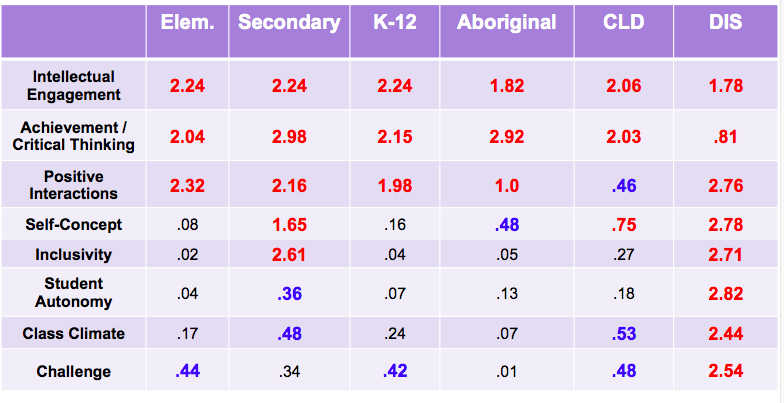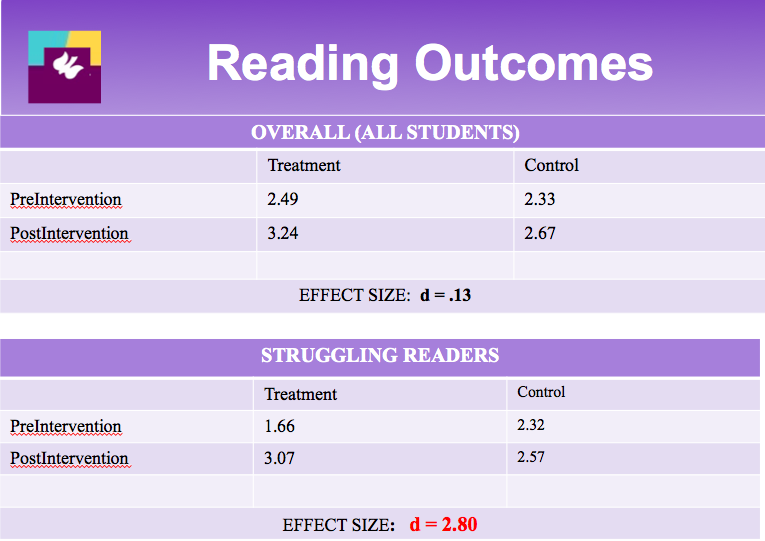Outcomes of Implementing the Three Block Model
Find out more about the Three-Block Model of UDL
For more info - go to articles page!
Summary
To date, studies investigating outcomes of the Three-Block Model of UDL have been overwhelmingly positive, and have also illuminated the challenges involved in large scale implementation and systems change. Research involving close to 3000 students have repeatedly shown increases in engagement, achievement, critical thinking, reading comprehension, positive behavior, self-concept, inclusivity, autonomy, and risk taking / safety. Teacher outcomes reveal improvements in job satisfaction, efficacy related to inclusion of students with significant disabilities, and school climate. Teachers and administrators note that initial training takes significant support and time, as teachers sit in grade groups to plan, and get used to a new way of planning (e.g. building rubrics is a new experience for many).
Below are the effect sizes found across studies investigating outcomes of the Three-Block Model. In Cohen's terminology, a small effect size is one in which there is a real effect -- i.e., something is really happening in the world -- but which you can only see through careful study. A 'large' effect size is an effect which is big enough, and/or consistent enough, that you may be able to see it 'with the naked eye'. For example, just by looking at a room full of people, you'd probably be able to tell that on average, the men were taller than the women -- this is what is meant by an effect which can be seen with the naked eye (actually, the d for the gender difference in height is about 1.4, which is really large, but it serves to illustrate the point). Given that, the d scores below of 2.0 something are unusually large. From a practical standpoint, it means if you walked into a room implementing the Three-Block Model, you would see a significant difference in students engagement, critical thinking, interactions, and so forth. It would be obvious! Effects in red are large effect sizes, which means the Three-Block Model had a very significant impact on these factors (for instance, student engagement). Effect sizes in blue are medium effect sizes, meaning that they improved these factors by about one year (if talking about achievement), or were impacting the majority of students.
In the chart below, the true meaning of universal design for learning can be found. We often talk about UDL as "designed for some, of benefit to all." In terms of reading, that is exactly what plays out. When we look at the overall effect size, it is small - .13. This means that all students benefitted, but only slightly. However, if you look at the students with reading difficulties, the effect size climbs to a very large 2.80. In other words, for students who are struggling readers, universally designed literacy programs are CRITICAL.
In Other Words...
|
Elementary School
- Increased critical thinking/achievement - Increased Active engagement: Students in UDL classes spent 44/60 minutes actively engaged, as compared to 22/60 minutes in typical inclusive classrooms. - Increased positive interactions with peers - Increased challenge level |
Secondary School
- Increased critical thinking / achievement - Increased Active engagement: Students in UDL classes spent 44/60 minutes actively engaged, as compared to 16/60 minutes in typical classrooms - Increased positive interactions with peers - Increased self-concept and inclusivity - Improved class climate and student autonomy/self-regulation |
Students with disabilities, students learning English as an additional language, and Indigenous students all benefitted significantly from implementation of the Three-Block Model.
Teacher Outcomes
Pedagogical Outcomes
Task: F(10,75) = 4.302, p<.001, d = .43
Grouping: F(10,75) = 12.158, p<.001, partial d = .94
|
Increased
- Differentiation of Tasks |
- Use of small group and partner cooperative groupings |
Teachers' Perceived Benefits & Challenges
Benefits
- Supported philosophy: felt like they could "meet the needs", do what they wanted to / believed in
- Improved self-efficacy regarding inclusion - Improved collegial relationships - Made inclusion "doable" and "enjoyable" - Less challenging behavior - Improved student engagement, risk taking - Improved student learning: deeper conceptual understanding, improved literacy and numeracy skills |
Challenges
- Need time to co-plan
- Scheduling in secondary schools limits ability to "go deep" - Need resources for diverse learners (eg multi-level texts) - Concerns about parents not understanding |


